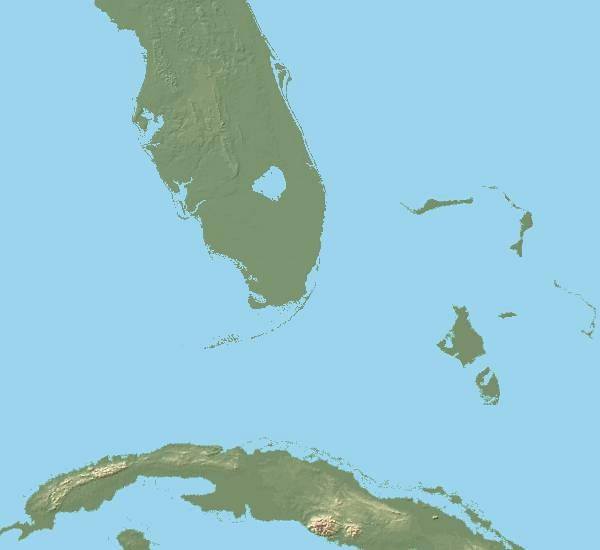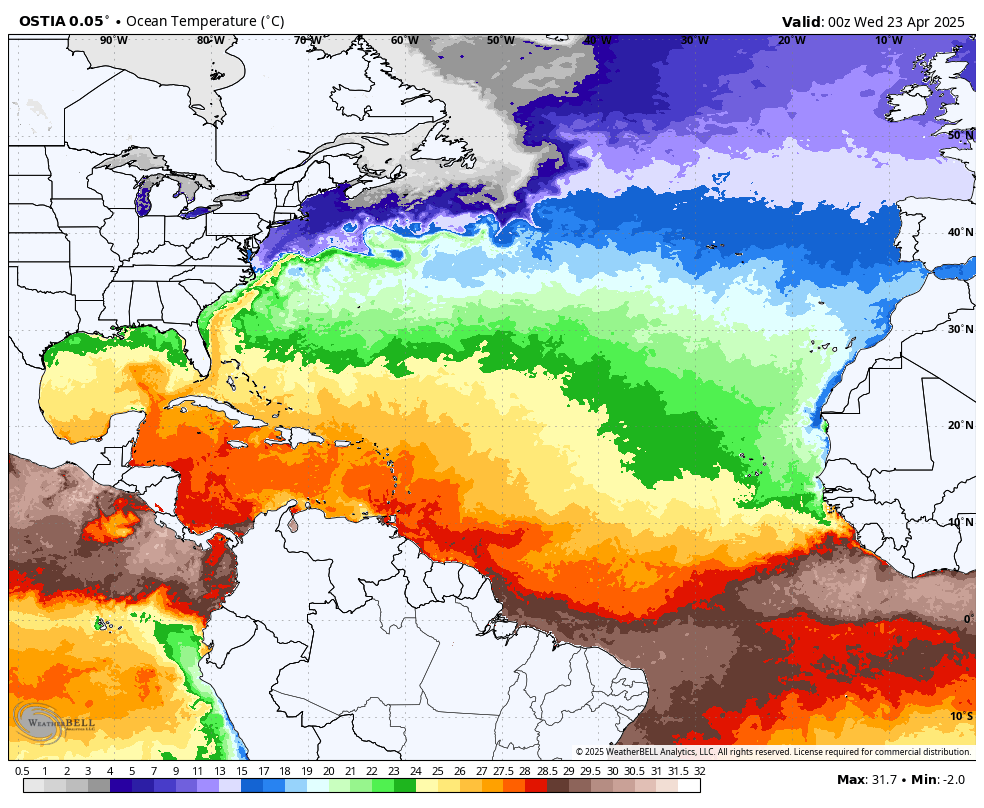-
![]()
[================================================================================ You are receiving this email from Sender: forecast.office@gmail.com Security Alert: External Email - This email originated from outside the Bahamas Government. Please do not click links or open attachments unless you recognize the sender and are sure the content is safe. Be vigilant against phishing attempts. If you notice any suspicious activity, report it immediately to the DICT Helpdesk via: Email: ditsupport@bahamas.gov.bs Or Telephone: 604-4688================================================================================
]BAHAMAS MARINE FORECAST
MARINE FORECASTS FOR THE BAHAMAS FOR THE NEXT 24 HOURS ISSUED BY THE BAHAMAS DEPARTMENT OF METEOROLOGY AT 6:00 A.M. EDT, Thursday, April 24, 2025. THE NEXT SCHEDULED FORECAST WILL BE ISSUED AT 12:00 P.M. EDT.
WARNINGS:
Beachgoers, sea bathers, and mariners are strongly encouraged NOT to enter Atlantic-
exposed waters due to high surf and a high risk of rip currents. Beachgoers and mariners are urged to exercise extreme caution along north and east coastal waters not directly exposed to the Atlantic, as the risk of rip currents is elevated.
GENERAL SITUATION:
The tight pressure gradient between a persistent high pressure system and a trough extending to near the Greater Antilles, generating fresh to moderate breeze throughout the archipelago. Streaming tropical moisture combined with mid to upper level troughing will increase showers and possible thunderstorms across the Central and Southeastern Islands.
Outlook: Troughing will continue to support showers in the Central and Southern islands into the weekend while high pressure remains over the area. Fresh to moderate breezes and choppy seas are expected to persist heading into next week.
NORTHERN BAHAMAS
(INCLUDING GRAND BAHAMA, ABACO, BIMINI & ADJACENT WATERS):
Small craft caution in effect
WINDS:
Easterly 15 knots, with higher gusts increasing to 15 to 20 knots tonight
LOCAL SEAS:
3 to 5 feet increasing to 4 to 6 feet tonight
GULF STREAM:
3 to 5 feet
SWELLS:
Moderate to large along Atlantic coastlines
WEATHER:
Windy with the chance of isolated showers
NORTHWEST BAHAMAS
(INCLUDING NEW PROVIDENCE, ANDROS, THE BERRY ISLANDS, ELEUTHERA & ADJACENT WATERS):
ADVISORY:
Small craft caution in effect
WINDS:
Northeast to east at 15 to 20 knots with higher gusts.
LOCAL SEAS:
4 to 7 feet
SWELLS:
Moderate to large along Atlantic coastlines
WEATHER:
Windy with isolated passing showers possible
CENTRAL BAHAMAS
(INCLUDING EXUMA, CAT ISLAND, LONG ISLAND, SAN SALVADOR, RUM CAY & ADJACENT WATERS):
ADVISORY:
Small craft caution in effect
WINDS:
Northeast to east at 15 to 20 knots with higher gusts.
LOCAL SEAS:
4 to 7 feet
SWELLS:
Moderate to large along Atlantic coastlines
WEATHER:
Windy with scattered showers and isolated thunderstorms
SOUTHEAST BAHAMAS
(INCLUDING INAGUA, ACKLINS, CROOKED ISLAND, MAYAGUANA, RAGGED ISLAND & ADJACENT WATERS):
ADVISORY:
Small craft caution in effect
WINDS:
Northeast to east at 15 to 20 knots with higher gusts.
LOCAL SEAS:
4 to 7 feet
SWELLS:
Moderate to large along Atlantic coastlines
WEATHER:
Windy with scattered showers and isolated thunderstorms
MOONSET:
MOONRISE:
04:27 PM
04:57 AM FRI
ISLAND TIDES:
NORTHERN
(GRAND BAHAMA):
NORTHWEST
(NEW PROVIDENCE):
CENTRAL
(EXUMA):
SOUTHEAST
(INAGUA):
LOW TIDE:
11:41 A.M.
11:39 A.M.
11:32 A.M.
12:01 P.M.
HIGH TIDE:
05:59 P.M.
05:50 P.M.
05:52 P.M.
06:06 P.M.
(For specific times for other islands, please see Tide Table Publication.)
EXTENDED FORECAST FOR THE BAHAMAS FOR: FRIDAY 25TH APRIL 2025
ADVISORY:
Small craft caution in effect for the Northwest, Central and Southeast Bahamas, small craft should avoid entering Atlantic waters
WINDS:
All areas: Northeast to East-northeast at 15 knots in the Northern Bahamas, increasing 15 to 20 knots with higher gusts in the Northwest, Central and Southeast Bahamas.
SEAS:
3 to 5 feet in the Northern Bahamas, 4 to 7 feet in the Northwest, Central and Southeast Bahamas
WEATHER:
Scattered showers and thunderstorms in the Central and Southeast Bahamas, chance of an isolated shower in the Northern and Northwest Bahamas
EXTENDED FORECAST FOR THE BAHAMAS FOR: SATURDAY 26TH APRIL 2025
ADVISORY:
Small craft caution in effect for the Northwest, Central and Southeast Bahamas, small craft should avoid entering Atlantic waters
WINDS:
All areas: Northeast to East-northeast at 15 knots in the Northern Bahamas, increasing 15 to 20 knots with higher gusts in the Northwest, Central and Southeast Bahamas.
SEAS:
3 to 5 feet in the Northern Bahamas, 4 to 7 feet in the Northwest, Central and Southeast Bahamas
WEATHER:
Scattered showers and thunderstorms in the Central and Southeast Bahamas, chance of an isolated shower in the Northern and Northwest Bahamas
THE BAHAMAS DEPARTMENT OF METEOROLOGY
Email: forecast.office@gmail.com or meteo@batelnet.bs
FORECASTER: SM
(Please view our products on our Bahamas Meteorology Facebook Page or our website, met.gov.bs.)
Bahamas Department of MeteorologyThe Airport Industrial Park Road,Airport Industrial Park (AIP)Nassau, BahamasTel: (242) 702-5279Feel free to give us your feedback on our forecast products via the link below:
This e-mail message and the information and any attachments contained herein are confidential to the addressee and may be subject to professional privilege. No other person may place any reliance on this e-mail nor its contents, nor copy or distribute it to any other person or use the contents in any unauthorised manner without the express permission of the sender. If you are not the addressee of this e-mail, or an employee or agent responsible for delivering this message to the addressee, please delete it and notify the sender as soon as possible. Thank You.[================================================================================ You are receiving this email from Sender: forecast.office@gmail.com Security Alert: External Email - This email originated from outside the Bahamas Government. Please do not click links or open attachments unless you recognize the sender and are sure the content is safe. Be vigilant against phishing attempts. If you notice any suspicious activity, report it immediately to the DICT Helpdesk via: Email: ditsupport@bahamas.gov.bs Or Telephone: 604-4688================================================================================
]BAHAMAS PUBLIC FORECAST
FORECASTS FOR THE BAHAMAS FOR TODAY, TONIGHT AND THE NEXT SIX (6) DAYS, ISSUED BY THE BAHAMAS DEPARTMENT OF METEOROLOGY AT 6:00 A.M. EDT, Thursday, April 24, 2025. THE NEXT SCHEDULED FORECAST WILL BE ISSUED AT 12:00 P.M. EDT.
WARNING IN EFFECT:
There are currently no public warnings in effect at this time.
GENERAL SITUATION:
The tight pressure gradient between a persistent high pressure system and a trough extending to near the Greater Antilles, is generating fresh to moderate breeze throughout the archipelago. Streaming tropical moisture combined with mid to upper level troughing will increase showers and possible thunderstorms across the Central and Southeastern Islands.
Outlook: Troughing will continue to support showers in the Central and Southern islands into the weekend while high pressure remains over the area. Fresh to moderate breezes and choppy seas are expected to persist heading into next week.
SPECIAL WEATHER
NOTES:
· There is a moderate to high risk of rip currents along eastern shorelines as well as possible rough surf conditions, especially along the Atlantic exposed waters. Therefore, beachgoers and swimmers should exercise extreme caution when entering these beaches.
· Due to the anticipated high UV indices tomorrow, the public is encouraged to limit outdoor exposure, and wear protective clothing and sunscreen late morning through to 4pm.
NORTHERN BAHAMAS
(INCLUDING GRAND BAHAMA, ABACO, BIMINI & ADJACENT WATERS):
SKY CONDITIONS:
Partly sunny and breezy becoming fair and windy tonight.
PRECIPITATION:
Less than 10% chance of showers.
WINDS:
Easterly 15 knots, with higher gusts increasing to 15 to 20 knots tonight
TEMPERATURES:
MAXIMUM:
MINIMUM:
HEAT INDEX:
81ºF – 84ºF / 27ºC – 29ºC
68ºF – 72ºF / 20ºC – 22ºC
N/A
NORTHWEST BAHAMAS
(INCLUDING NEW PROVIDENCE, ANDROS, THE BERRY ISLANDS, ELEUTHERA & ADJACENT WATERS):
SKY CONDITIONS:
Partly sunny and breezy becoming fair and windy tonight.
PRECIPITATION:
10-20% chance of isolated showers.
WINDS:
Northeast to east at 15 to 20 knots with higher gusts.
TEMPERATURES:
MAXIMUM:
MINIMUM:
HEAT INDEX:
81ºF – 84ºF / 27ºC – 29ºC
70ºF – 73ºF / 21ºC – 23ºC
N/A
CENTRAL BAHAMAS
(INCLUDING EXUMA, CAT ISLAND, LONG ISLAND, SAN SALVADOR, RUM CAY & ADJACENT WATERS):
SKY CONDITIONS:
Partly cloudy and breezy through tonight.
PRECIPITATION:
20 to 30% chance of isolated showers or a thunderstorm.
WINDS:
Northeast to east at 15 to 20 knots with higher gusts.
TEMPERATURES:
MAXIMUM:
MINIMUM:
HEAT INDEX:
82ºF – 86ºF / 28ºC – 30ºC
72ºF – 75ºF / 22ºC – 24ºC
N/A
SOUTHEAST BAHAMAS
(INCLUDING INAGUA, ACKLINS, CROOKED ISLAND, MAYAGUANA, RAGGED ISLAND & ADJACENT WATERS):
SKY CONDITIONS:
Partly cloudy and breezy through tonight.
PRECIPITATION:
20 to 30% chance of widely scattered showers or isolated thunderstorms
WINDS:
Northeast at 15 to 20 knots with higher gusts
TEMPERATURES:
MAXIMUM:
MINIMUM:
HEAT INDEX:
82ºF – 88ºF / 28ºC – 31ºC
72ºF – 75ºF / 22ºC – 24ºC
N/A
EXTENDED FORECAST FOR THE BAHAMAS FOR: FRIDAY 25TH, APRIL 2025.
SKY CONDITIONS:
Partly cloudy during the day, turning mostly fair at night.
PRECIPITATION:
10% chance of a stray shower or two in the Northern and Northwest Bahamas, 20-30% chance of showers with a few thunderstorms possible in the Central and Southeast Bahamas.
WINDS:
All areas: Northeast to East-northeast at 15 knots in the Northern Bahamas, increasing 15 to 20 knots with higher gusts in the Northwest, Central and Southeast Bahamas.
TEMPERATURES:
MAXIMUM:
MINIMUM:
HEAT INDEX:
79F – 85ºF / 26ºC – 29ºC
68ºF – 75ºF / 20ºC – 24ºC
N/A
EXTENDED FORECAST FOR THE BAHAMAS FOR: SATURDAY 26TH, APRIL 2025.
SKY CONDITIONS:
Partly sunny during the day, becoming mostly fair at night.
PRECIPITATION:
10% chance of a stray shower or two in the Northern and Northwest Bahamas, 20-30% chance in the Central and Southeast Bahamas. Expect a few isolated thunderstorms mainly in the Southeast Bahamas.
WINDS:
All areas: Northeast to East-northeast at 15 knots in the Northern Bahamas, increasing 15 to 20 knots with higher gusts in the Northwest, Central and Southeast Bahamas.
TEMPERATURES:
MAXIMUM:
MINIMUM:
HEAT INDEX:
79F – 85ºF / 26ºC – 29ºC
68ºF – 75ºF / 20ºC – 24ºC
N/A
EXTENDED FORECAST FOR THE BAHAMAS FOR: SUNDAY 27TH, APRIL 2025.
SKY CONDITIONS:
Partly sunny during the day, becoming mostly fair at night.
PRECIPITATION:
10% chance of a stray shower or two in the Northern and Northwest Bahamas, 20-30% chance in the Central and Southeast Bahamas. Expect a few isolated thunderstorms mainly in the Southeast Bahamas.
WINDS:
All Areas: Northeasterly at 10 to 15 knots, falling light and variable in the Northern Bahamas.
TEMPERATURES:
MAXIMUM:
MINIMUM:
HEAT INDEX:
79F – 85ºF / 26ºC – 29ºC
68ºF – 75ºF / 20ºC – 24ºC
N/A
EXTENDED FORECAST FOR THE BAHAMAS FOR: MONDAY 28TH, APRIL 2025.
SKY CONDITIONS:
Partly sunny during the day, becoming mostly fair at night.
PRECIPITATION:
10% chance of a stray shower or two in the Northern and Northwest Bahamas, 20% chance in the Central and Southeast Bahamas.
WINDS:
All Areas: Northeasterly at 10 to 15 knots increasing to 15 knots.
TEMPERATURES:
MAXIMUM:
No severe weather conditions are currently in effect-
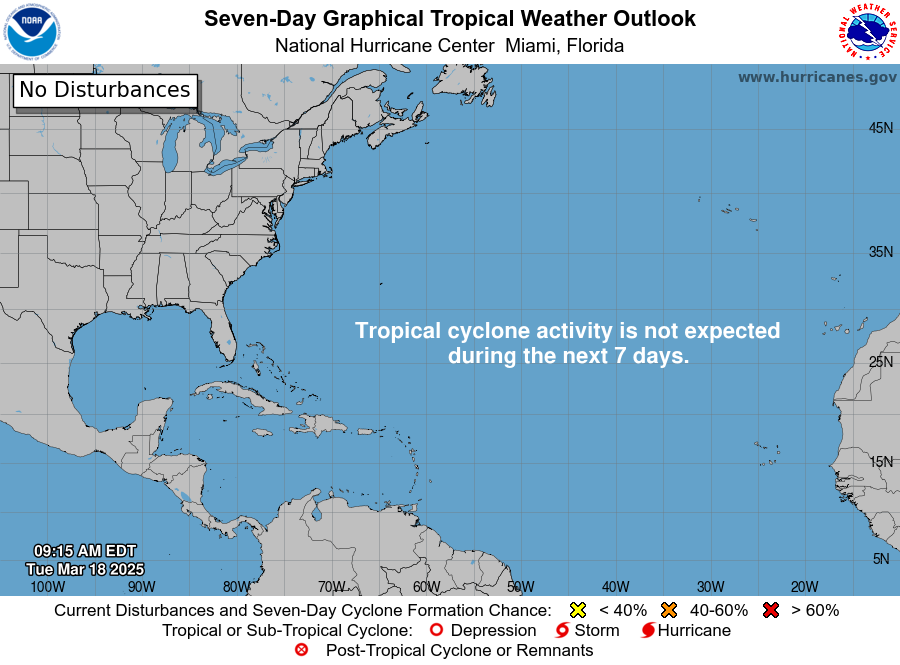
![]()
![]() No ATCF storm tracks currently available
No ATCF storm tracks currently available
-
-
There is no content.
April 7, 2025
- The 2025 Hurricane Season should have fewer impacts than 2024, but they will still be above normal.
- We are expecting an eastward and northward shift from the core of impacts from last year.
- Changes in the Atlantic Basin are much more important than any weak ENSO signal.
- There are no changes to the numbers from the first forecast.
- There is excellent support from the Euro.
- Other forecasters have followed our lead, indicating there is some independent consensus on numbers.
- The total number is not as important as the impacts.
- The Power and Impact scale is a far better indicator of overall storm strength and likely extent of damage.
- Fly in the ointment sudden warming in ENSO 1 is wild card
Forecast according to the Power & Impact Scale
Named Storms: 15-19 ( Saffir Simpson, same)
Category 1 or greater hurricanes: 7-9 ( Saffir Simpson, same)
Category 2.5 (start of Power & Impact major hurricane classification): 3Saffir-Simpson Hurricane Wind Scale Forecast
Named Storms: 15-19
Total Hurricanes: 7-9
Major Hurricanes: 2-3
ACE Index: 120-150Impact Forecast
Tropical Storm Conditions: 5-7
Total Hurricanes: 3-4
Major Hurricanes: 1-2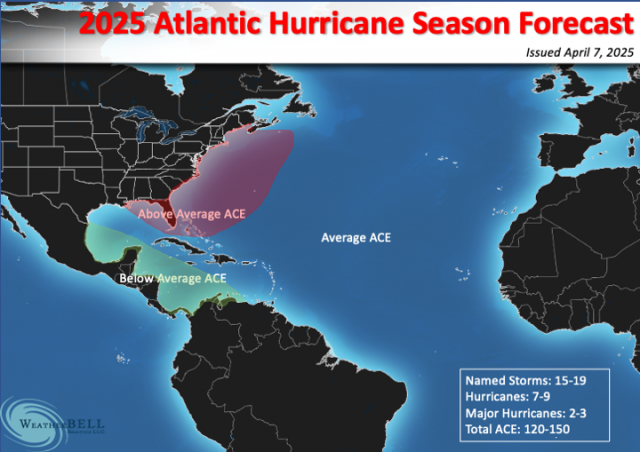
This update is to add the impact areas and below-average areas and draw a contrast to last season. In short, we don't expect it to be as bad as last season, but we still expect above normal impacts on the U.S. coast. The core area of impacts is liable to be to the northeast of last year's.
What is now being honed in on is the impact area, the red zone, and also, like in 2019, a green zone. Amazingly, that year saw Dorian, the beast actually waited to explode until out of the zone we forecasted:
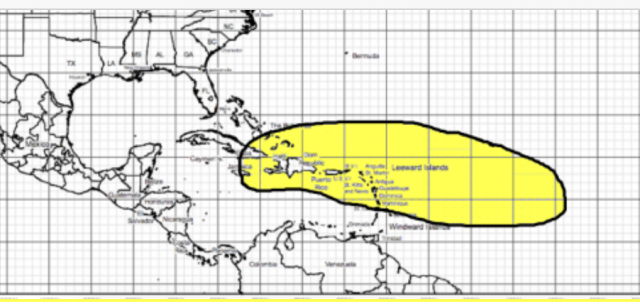
Dorian:
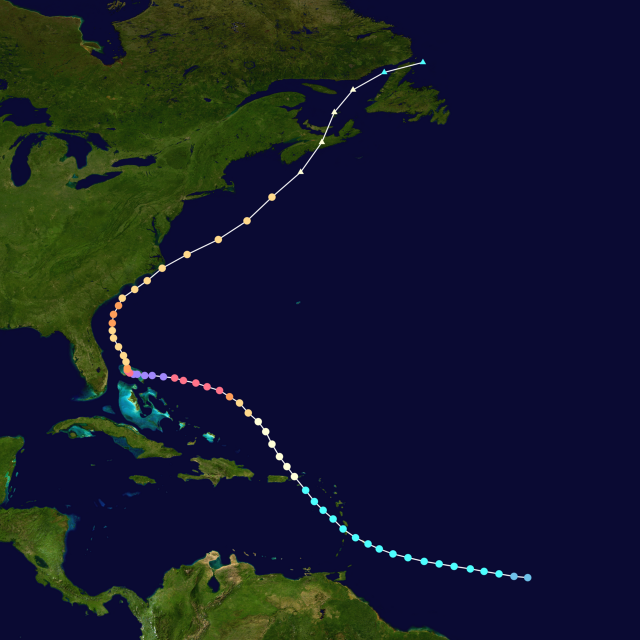
That was classic, exploding after the bend back to the west. Like all the majors more than two days away, it hit off its peak when it reached the U.S. That below-average area this year is an area where Beryl was near its strongest last year. As a side note, SSTs are quite close to that 2019 analog. This year:
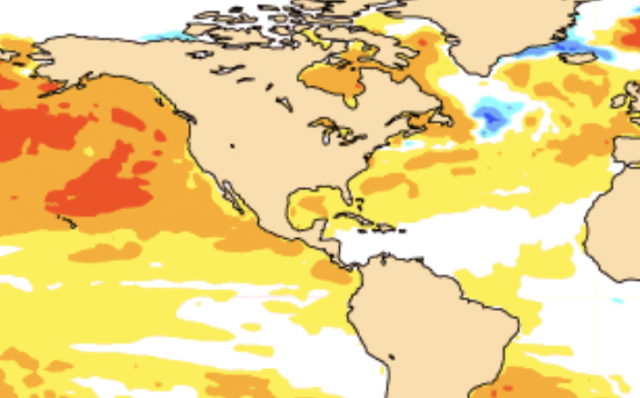
2019:
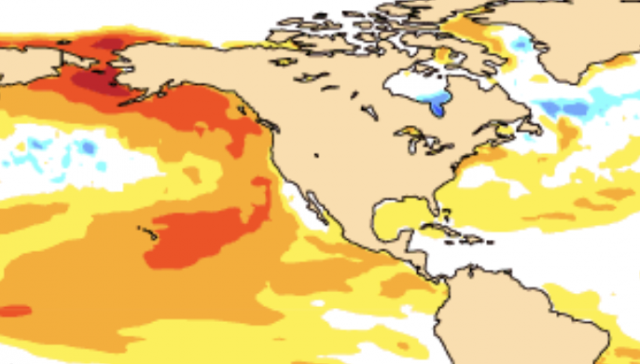
The totals for the 2019 season:
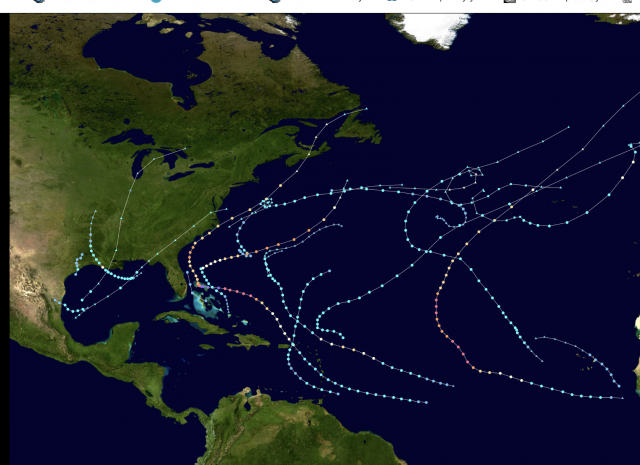
Commentary
A word about our forecast: I believe the whole total number game is a red herring. We have been pioneering since 2011 where the bulk of the ACE index relative to average will show up, the so-called red zones. There have been years, like this year, where you will notice areas of less than average ACE (expected in the southern and central Caribbean this year). I am noticing that other forecast entities have followed our issuance on February 7 with similar total numbers. I applaud their attempts at also doing what we have been doing - trying to show where they believe the action will be the greatest.
I suspect that in the coming years, the National Hurricane Center will do this, and they will also come up with something along the lines of our Power & Impact scale to replace the outdated Saffir-Simpson scale. A spot wind at one point does not do justice to the entire hurricane and also means storms that are much smaller in extent can be put in the same category as storms that are much larger. The whole climate debate and the use of the Saffir-Simpson scale to promote a missive of "it's getting worse than ever" also demands a further rehauling and reanalysis of the history of hurricanes. Even the National Hurricane Center admits that "size matters", but their reliance on a single reading for the Saffir-Simpson scale belies that notion.
It would also be smart for the Atlantic Basin to be divided into two separate areas so the total numbers game can be more realistic. A suggestion would be that all storms that develop to the north of 35°N and to the east of 60° West be in a different category unless they turn back into the traditional areas that we have known about for over a century.
There will never be a better impact forecast than the one issued for last year on December 7, 2023:
.png)
I have been doing a lot of research on these Gulf-centric seasons, like last year. In the years following, three stick out in particular because they came off of El Niños, and then the analog is the following season.
The first is 1995:
.png)
Notice two congregations of tracks - the lesser one but still pronounced over the Gulf and the one out at sea.
The following year was between the two:
.png)
1998 had one main track at sea, and the other closer in:
.png)
The centering of such seasons was Brownsville to Cape Hatteras. The following year, while there was also a batch out at sea, there was also a cluster near the Southeast coast:
.png)
While much has been made, and rightly so, about how perilous the western coast of the Florida Peninsula has become over the past several years, just as astounding has been the lack of a landfalling major hurricane on Long Island or in New England since 1991. There has also not been a direct major hurricane hit to the south of West Palm Beach Florida to Key Largo since Andrew in 1992. The shift to the north of the main region of genesis and overall lower pressures across the global basins (including the Atlantic Basin) may have something to do with this. A storm developing to the north of 25°N and to the west of 80°W has the Gulf Coast to hit, as most of these storms have been deepening while moving more northward than westward (or, in the case of Miltion, the opposite of west). This is because of the phases of the MJO we were in and the fact that convergence naturally increases in the coastal waters if a hurricane is moving perpendicular to the coast rather than parallel to it.
In any case, longer-tracked storms have all hit the U.S. off their peak (i.e., more than two days out, they were stronger), while the more compact storms are the ones that have been deepening rapidly coming to the coast. The size of storms has also been much smaller. Helene is an exception, as it was a "big" storm size-wise. The question is when will southeastern Florida see a return to this active pattern?:
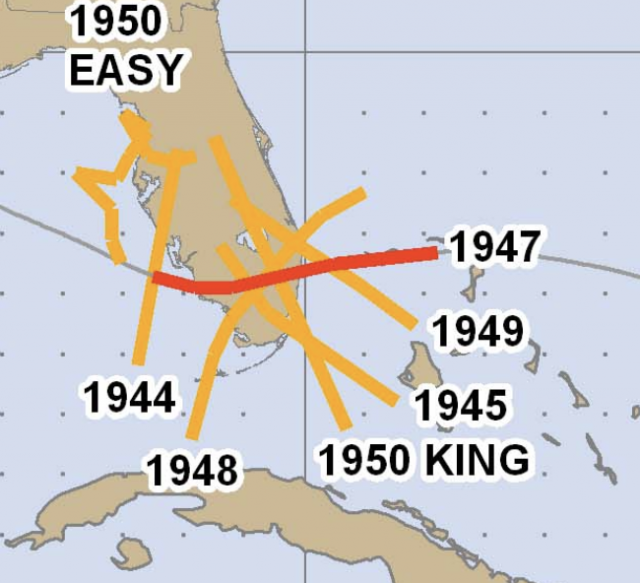
In some ways, what is going on for the western coast of Florida is their version of what went on in the 1940s on the southeastern coast. Farther to the north, while we have had Category 4s near the Bahamas, such as Floyd and Irene, neither made it to New England as hurricanes. The very fact that the impact forecast has the area of highest ACE relative to averages to the north, not to the south and east of the Caribbean, ups the ante for New England, as all the hurricanes that hit New England from 1938 to 1991 either came through there or developed there. Carol, Belle, and Bob were all late bloomers.
Comparisons to last year at this time
The SSTs are vastly different. The warmth of the Atlantic means the ENSO events have little effect on the total numbers (as we saw two years ago). To some extent, a warm event does protect much of the U.S. Gulf coast, as the 2023 season was all out to sea. I issued that December forecast for 24, anticipating the Euro going to what it did.
The Euro's SST forecast last year was a classic one. In retrospect, the warmth made sure the energy was in the Tropics for the origins and not all over the place for those "ham sandwiches" that get named in the middle of nowhere. We had next to none of those last year, and I had counted on several in playing the numbers game. I had 5 more than the base number because of those expectations, but that numbers game is a red herring and an attempt to avoid real forecasting, which is taking a shot at where they will go. The idea that bigger numbers mean bigger impacts does not always work - just look at 2010.
Last year's forecast:
.png)
This year's forecast:
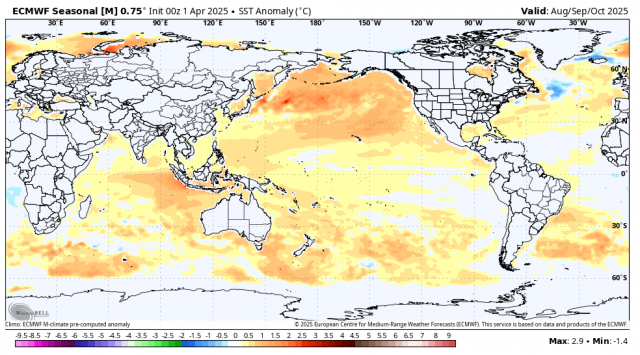
This has a much cooler Atlantic Basin, and the warm water is shown to the north, which is a distorted energy signal. However, with more warm water in the North Pacific and closer to the coast, it would lead to troughs wanting to spin down into the Tennessee Valley and pick up features in the southwestern part of the North Atlantic Basin. Still, it's a very different look.
The Euro's precipitaton forecast is almost 180 degrees opposite of last year. 2024:
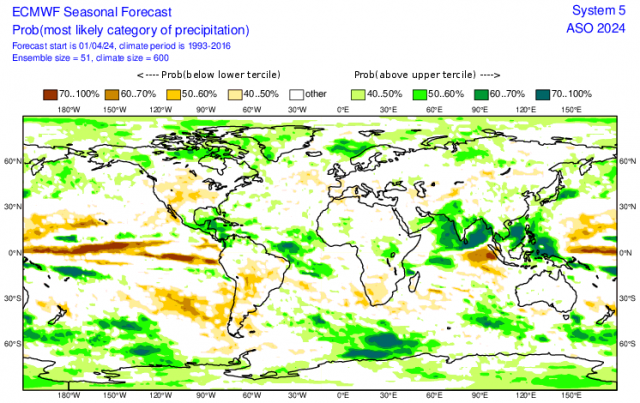
Note the heavy rain forecast in the central and northern Indian Ocean, indicating the active African wave train we saw last year. Of course, we see all the heavy rainfall where the high impacts were (our forecast for that was put out 5 months beforehand).
This year, the forecast is drier:
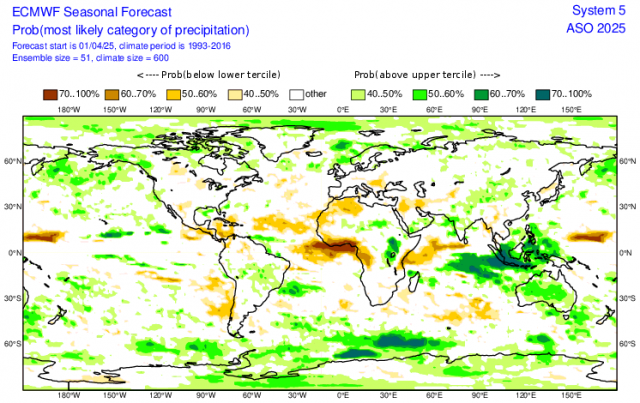
Notice the enhancement in-close to the Southeast Coast. That is a bit more of a Phase 4 & 5 look over the Indian Ocean, which is not as bullish as last year's.
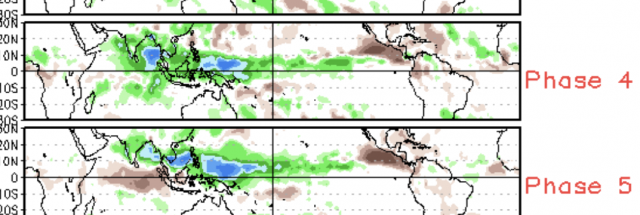
It should be noted that we really caught a break last year when the MJO went into the non-favored phases for a time at the height of the season. If you had been reading along in August, we caught that and knew there would be a furious endgame to the season.
Close-up view of North America:
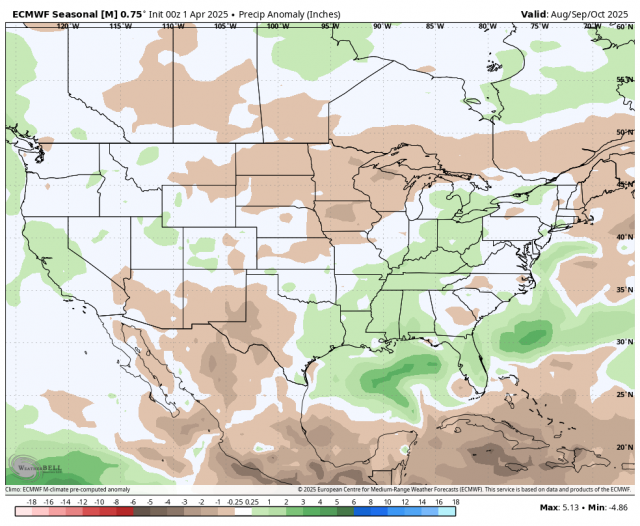
We do not have the Gulf below normal - in fact, it's above normal to the east, but that is quite different over the Caribbean.
The SLP forecast last year was neutral in much of the basin:
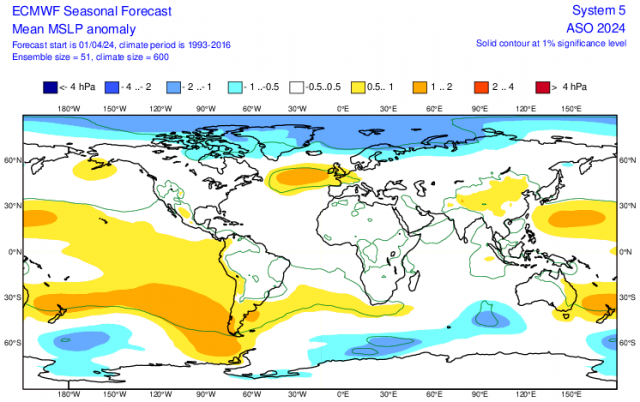
This year, it's above average, but crucially highest in the North Atlantic.
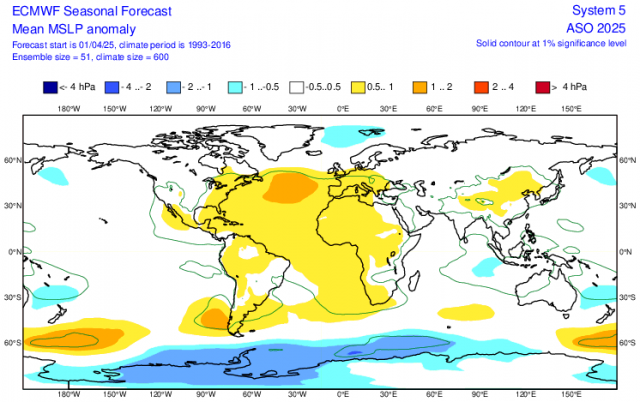
This is one of those seasons when the Power & Impact scale will describe a storm better, as they may be higher on the Saffir-Simpson scale due to its one-dimensional aspect (max spot wind speed). Ours has several metrics of wind speed, wind radii, pressure, and pressure tendency.
At 500 mb, the ridge from west to east to the north of 40°N is something that leaves the U.S. coast open. Last year:
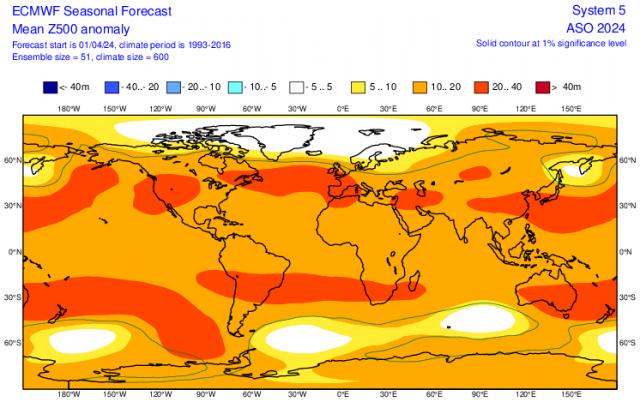
This year:
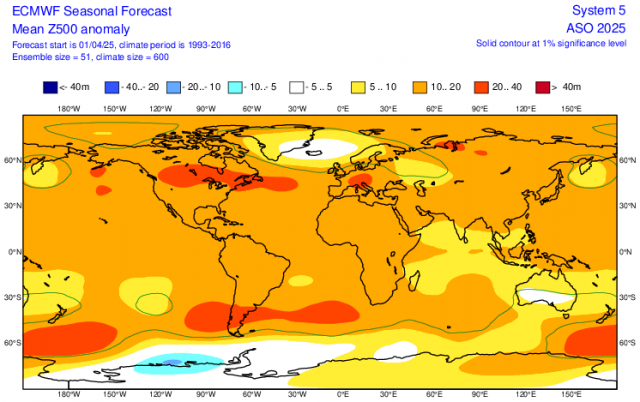
I am not concerned about the ENSO. Last year's La Niña was overforecasted, but it was still a hurricane season from hell. This year, the impacts are not expected to be as great, but I still think an above-average season is on tap.
Here a comment on sudden warming in the Nino 1+2 area is necessary. All this is fine and dandy, but basing a forecast on a forecast, especially in the age of sudden warming events, is tricky. Nino 1+2 is the area off the northern coast of South America. When it's warm there, it means the Columbian heat low is stronger, and that enhances low-level easterlies in the Caribbbean and increases shear. As of February, the models had no idea what was actually going to happen in April. This is what they were expecting:
.png)
Instead, we have this:
.png)
It appears to be linked to a sudden increase in underwater volcanic activity in this area, which models cannot see until it's too late (and we don't get reports on this until it's too late):
.png)
So this is a wild card and could impact the forecast going forward, and is something we will have to watch closely.
The Verdict
There is no change in the overall numbers here. There is no question that what we saw in December 2023 stood out so much so that from that far out, we hit the hurricane season from hell (the second costliest on record). I was overdone in the numbers game, though. With a less impressive look this year, I am expecting there to be fewer true tropical cyclones, but there is going to be a better chance for the "ham sandwiches" in the North Atlantic to pump up numbers.
This season will be a year where in-close development is a concern, as it has been recently, due to the distortion of overall feedback patterns likely brought about by the distortion of warming, the Global Wind Oscillation, and Sea Level Pressure patterns.
So an active season is anticipated but not as bad as last year. Remember, 2020 was very bad, and 2021 was not as bad but still stronger than average. Perhaps that is an interesting analog, too.
we - The 2025 Hurricane Season should have fewer impacts than 2024, but they will still be above normal.
